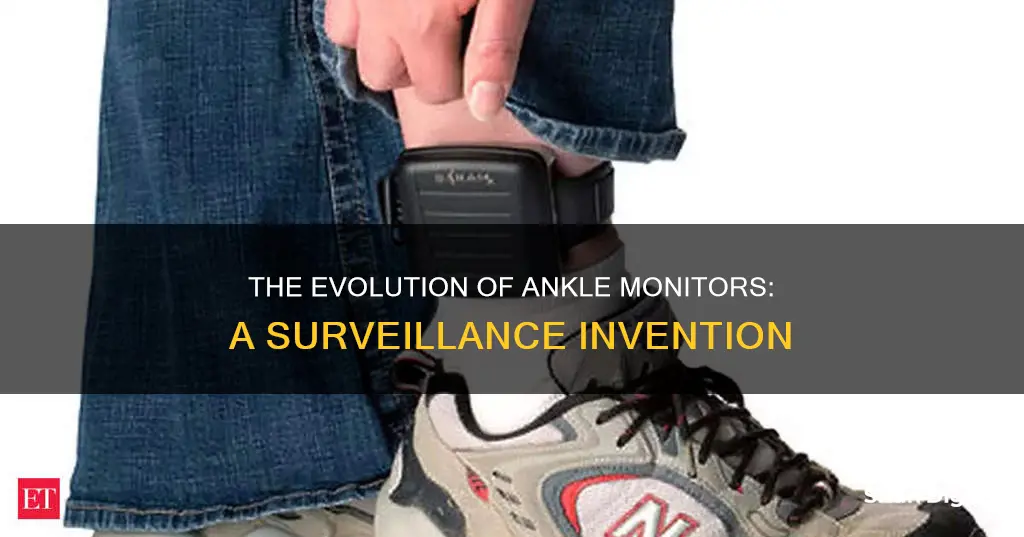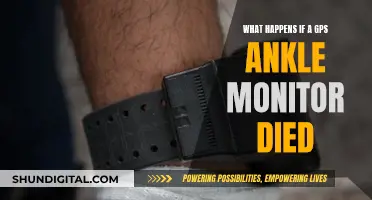
The ankle monitor, or electronic tagging device, was first invented in the 1960s by twin brothers Robert and Kirk Gable, psychology students at Harvard University. The device was initially designed to monitor the movements of juvenile offenders and encourage them to show up to places on time, with the intention of providing positive reinforcement in the form of rewards. The technology has since evolved to include GPS and cell tower signals, allowing for precise location monitoring. While the ankle monitor has become a significant part of the criminal justice system, its inventors had envisioned a different purpose, aiming for rehabilitation and behaviour modification rather than solely punishment and surveillance.
| Characteristics | Values |
|---|---|
| Name of Inventors | Robert Gable and his twin brother, Kirkland Gable (born Ralph Kirkland Schwitzgebel) |
| Year of Invention | 1960s |
| University | Harvard University |
| Academic Advisors | B.F. Skinner and Timothy Leary |
| Original Purpose | To monitor the movements of juvenile offenders and encourage them to show up to places on time as a form of positive reinforcement |
| Original Design | A system in which offenders would wear radio devices that communicated their location |
| Original Target Users | Young offenders |
| Original Rewards | Free haircut, pizza, concert tickets |
| Current Use | Tracking sex offenders, DUI offenders, people free on bail, etc. |
What You'll Learn

The original ankle monitor inventors
The Gable brothers' invention, which they described in the journal Behavioral Science in 1964, was intended to be a system that would automatically track the movements of young offenders and provide positive reinforcement when they showed up at the right place at the right time. The rewards would be simple treats, such as a free haircut, pizza, or concert tickets, to inspire the offenders to behave better.
The portable electronic tag was called a behaviour transmitter-reinforcer and could transmit data two-ways between a base station and a volunteer simulating a young adult offender. The head of this research project was Ralph Kirkland Schwitzgebel (Robert and Kirk's original surname) and his twin brother collaborator, Robert Schwitzgebel (who later shortened their surname to Gable).
The idea for the ankle monitor was inspired by the possibility of training pigeons to play Ping-Pong, and the desire to apply operant conditioning to human social problems. The Gable brothers' invention has evolved over time, with modern devices using GPS and cell tower signals to give precise locations, and monitors for DUI offenders that can detect blood-alcohol levels through a person's sweat.
Repairing LCD Monitor Power Supply Issues: A Step-by-Step Guide
You may want to see also

The evolution of ankle monitors
The idea for the ankle monitor, or electronic monitoring device, was first conceived in the early 1960s by identical twin brothers Robert and Kirk Gable, graduate students of psychology at Harvard University. Inspired by B.F. Skinner's work on behavioural psychology, the Gables envisioned a system that would track and reward young offenders for showing up at the right place at the right time, thereby modifying their behaviour through positive reinforcement. The device, which they described in the 1964 edition of the journal *Behavioral Science*, was intended to be a game that would help juvenile offenders change their ways.
The Gables' invention was the first of its kind, and the technology behind it was primitive compared to today's standards. Using surplus missile-tracking equipment, the system involved offenders wearing radio devices that communicated their location. The radio signals would be transmitted two-ways between a base station and the volunteer simulating a young adult offender, with messages sent to the device to provide positive reinforcement.
Despite the novel idea, the Gables' invention was not without its sceptics and critics. The prototype was mocked in the 1966 edition of the *Harvard Law Review*, and a myth emerged that the device used brain implants and transmitted verbal instructions to volunteers. The editor of a well-known US government publication, *Federal Probation*, rejected an article submitted by Ralph Kirkland Schwitzgebel (Robert Gable's original surname), stating that the technology would turn parolees into "automatons" and that it would be more appropriate for rearing children.
The concept of electronic monitoring lay dormant until the 1980s, when Arizona state district judge Jack Love convinced a former Honeywell sales representative, Michael T. Goss, to start a monitoring company, National Incarceration Monitor and Control Services (NIMCOS). NIMCOS developed credit card-sized transmitters that could be strapped onto the ankle, sending a radio signal every 60 seconds to a receiver connected to a telephone. This data would then be transmitted to a mainframe computer.
While the NIMCOS ankle monitor successfully reported potential home detention breaches, it did not achieve the goal of reducing crime through probation. Two out of the three offenders who trialled the device in 1983 re-offended, highlighting the limitations of the technology at the time.
Since its early beginnings, the ankle monitor has evolved significantly. Today, many devices use GPS and cell tower signals to provide precise locations, and monitors can even detect blood-alcohol levels through an offender's sweat. The technology has become a significant part of the criminal justice system, with law enforcement using it to track sex offenders, DUI offenders, and people free on bail, among others.
Despite the advancements, the system is not without its flaws. Devices can send false alerts, and the large volume of alerts can overwhelm officers, making it challenging to respond to all of them promptly. Additionally, the original intent of the Gables' invention—to use positive reinforcement to modify behaviour—has largely been overlooked, with the technology primarily used as a form of punishment and surveillance.
Tucson's Best Places to Sell Your Old Monitors
You may want to see also

Ankle monitors in popular culture
Ankle monitors, also known as electronic tags, have been referenced in popular culture, including in television and films. They are also associated with celebrities such as Paris Hilton and Martha Stewart.
In 2005, English professional footballer Jermaine Pennant played a Premier League match while wearing an electronic tag on his ankle for drunk driving and driving while disqualified.
Lindsay Lohan was ordered to wear a Secure Continuous Remote Alcohol Monitor (SCRAM) bracelet to monitor her sobriety after she failed to appear at a mandatory hearing.
Roman Polanski, one of the most famous fugitives from American justice, was arrested in Switzerland in 2009. As part of his $4.5 million bail agreement, he was placed under house arrest and had to wear an ankle bracelet at his chalet in the Swiss ski resort of Gstaad.
Dr. Dre (Andre Young), an American rapper and record producer, was arrested in 1992 for assaulting record producer Damon Thomas. He pleaded guilty to assault and served house arrest, wearing a police monitoring ankle bracelet.
Anna Sorokin (Anna Delvey), a Russian con artist convicted of multiple counts of theft and grand larceny, was put under house arrest and required to wear an ankle monitor after her release from prison. She was detained by immigration authorities for overstaying her visa.
In popular culture, ankle monitors are often portrayed as an alternative to incarceration, but their representation in the media is not always accurate. While they can provide valuable data for research studies and potentially deter crime, their effectiveness depends on various factors, including appropriate offender selection and prompt response to breaches.
Monitoring App Bandwidth: A Comprehensive Guide to Track Usage
You may want to see also

Ankle monitor use cases
Ankle monitors, also known as electronic monitoring devices, have been used in the criminal justice system for several decades. While the technology has evolved over time, the basic concept remains the same: to track an individual's movements and ensure compliance with court-ordered restrictions. Here are some common use cases for ankle monitors:
Supervising Location and Movement
One of the most common uses for ankle monitors is to supervise the wearer's location and movement. This is often employed for individuals who are under house arrest or on parole. By using GPS technology or radio frequency, the monitor transmits the wearer's location to a monitoring center or law enforcement agency. This allows authorities to ensure that the wearer is adhering to any court-ordered movement restrictions, such as staying within a certain radius of their home or maintaining a required distance from certain individuals or places.
Alcohol Consumption Monitoring
Another important use case for ankle monitors is the detection and monitoring of alcohol consumption. These monitors, known as Secure Continuous Remote Alcohol Monitoring (SCRAM) devices, analyze the wearer's sweat to determine the presence of alcohol. This type of monitor is typically used for individuals with alcohol-related offenses, such as driving under the influence (DUI) or driving while intoxicated (DWI). By preventing the wearer from consuming alcohol, the monitor serves as a punishment or rehabilitation tool.
Alternative to Incarceration
Ankle monitors are often used as an alternative to traditional incarceration. In cases where jail systems are overcrowded, ankle monitors provide a way to punish individuals without placing them in prison. This is especially relevant for individuals charged with lesser or non-violent crimes, who may be released on bail or placed under house arrest with an ankle monitor as a condition of their release.
Pre-section Detention Alternative
In some cases, ankle monitors can be used as an alternative to pre-trial detention. For example, if an individual is deemed a low-risk offender or is facing their first offense, a judge may allow them to remain free while awaiting trial, provided they wear an ankle monitor and adhere to certain conditions set by the court. This could include sticking to a specific area, avoiding certain people, or adhering to a curfew.
Immigration Proceedings
Individuals awaiting court dates for immigration proceedings may also be required to wear ankle monitors. This allows authorities to track their location and ensure they do not leave the country before their court appearances.
Reducing Bail Amounts
In some cases, agreeing to wear an ankle monitor can result in a reduction in bail amounts. By wearing the monitor, the defendant essentially promises the court that they will not flee or violate the conditions of their release. This can increase the chance of getting a lower bail amount or even no bail at all. However, failing to wear the monitor or violating its conditions could result in higher bail amounts or other penalties.
Ankle Monitors: Who's Being Tracked and Why?
You may want to see also

The future of ankle monitors
The ankle monitor, or electronic tagging device, was first designed in the 1960s by twin brothers Robert and Kirk Gable, psychology students at Harvard University. The technology has evolved since then, and today, ankle monitors are commonly used by courts as a cost-effective alternative to incarceration.
Increased Use of GPS and Cellular Technology:
Ankle monitors have already started incorporating GPS and cellular signals to provide more precise location tracking. This trend is likely to continue, with devices becoming even more accurate and reliable in their ability to monitor an individual's whereabouts.
Enhanced Physiological Monitoring:
There may be a move towards more advanced physiological monitoring capabilities in ankle monitors. For example, some wearables in the consumer market can predict when a couple is about to have a fight. Similarly, ankle monitors could potentially track an individual's health conditions, sleep patterns, or even mood changes. This type of monitoring raises significant ethical concerns and would likely face strong opposition from privacy advocates.
Expansion into Predictive Analytics:
By combining sophisticated algorithmic analysis with physiological data, ankle monitors could potentially become predictive tools. For example, software that logs an individual's movements and habits could be used to detect suspicious behavior or predict the likelihood of reoffending. This predictive capability could be valuable for law enforcement but would also raise serious ethical and legal questions.
Improved Battery Life and Durability:
One of the challenges with current ankle monitors is the need for frequent recharging, which can be inconvenient and restrictive for the wearer. Future devices may focus on improving battery life, reducing the recharge frequency, and increasing overall durability.
Expansion of Usage Beyond Criminal Justice:
Ankle monitors have already started to be used in non-criminal justice contexts, such as in healthcare settings and immigration cases. This trend may continue, with ankle monitors being utilized for a broader range of applications, such as monitoring individuals with dementia or tracking the movements of migrants. However, this expansion of usage is likely to face strong ethical and legal scrutiny.
Addressing Privacy and Dignity Concerns:
The increased capabilities of ankle monitors, such as two-way communication and advanced physiological tracking, have raised concerns about privacy and dignity. Future developments in ankle monitor technology will need to carefully consider these concerns and find a balance between effective monitoring and respecting the rights of individuals.
Oxygen Tip Monitor Buying Guide: Where to Purchase
You may want to see also
Frequently asked questions
The first electronic monitoring system was invented by identical twin brothers Robert and Kirk Gable in the 1960s while they were studying at Harvard University.
The ankle monitor was originally intended to monitor the movements of juvenile offenders and encourage them to show up to places on time. The inventors envisioned a system that would reward young offenders for good behaviour as a form of positive reinforcement.
The ankle monitor is an electronic device that is affixed above the ankle. It can be used in combination with the global positioning system (GPS) or radio frequency technology to monitor an individual's location.
Today, the ankle monitor is used by courts as a cost-effective alternative to incarceration. It is often employed as a condition of bail, probation, or parole to monitor an individual's compliance with court-ordered restrictions, such as home detention or curfews.
There are concerns that the use of ankle monitors has become overly punitive and focused on punishment rather than rehabilitation. Additionally, there are privacy and human rights concerns surrounding the use of electronic monitoring, particularly in healthcare settings and for individuals with dementia.







